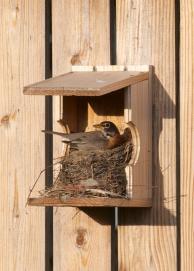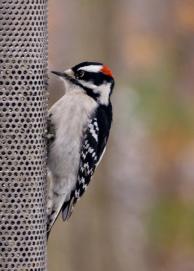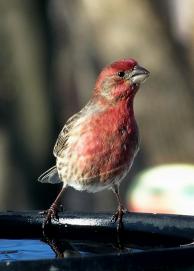Blue Jay
 Sounding its shrill call from treetops and look- outs, you understand why the Blue Jay, Cyanocitta cristata, is known as nature’s alarm call. Noisy and aggressive, the Blue Jay’s reputation may be mixed, but its beauty is undeniable.
Sounding its shrill call from treetops and look- outs, you understand why the Blue Jay, Cyanocitta cristata, is known as nature’s alarm call. Noisy and aggressive, the Blue Jay’s reputation may be mixed, but its beauty is undeniable.
Lavender blue to sky blue upper parts, a distinct blue crest and flashy white-tipped tail and wing spots mark this beautiful 11-12 inch winged alarmist. Its face and undersides are white to off-white and the neck is ringed with black.
The ubiquitous Blue Jay is one of our most reliable sightings on outings and frequent visitors to feeders. They are often found near oak trees, forest edges, parks and woodlots. Favorite foods are acorns, and when available at feeders, peanuts.
Blue Jays can grab several food items at once, squeeze them into throat pouches and cache them in hiding places to consume later. They often hold sunflower seeds with their feet to crack open with their stout bill.
Blue Jays make a large variety of calls but their shrill, descending cry is most common. The warning scream, usually made while perched, carries long distances. Blue Jays often mimic neighboring hawks.
Like other corvids, Blue Jays are very curious and highly intelligent. They may watch for a person to put food out and when the person walks away they will swoop down to nab it. They also can be observed with head swiveling while in flight, evaluating the landscape.
Blue Jays are quite territorial and may drive away others for an easy meal at a feeder. They are relatively slow fliers and are easy prey for hawks when flying in open areas. Provided they can avoid that fate, Blue Jays can live an average of 7 to 9 years in the wild.
Migration of the species is not fully understood. Some travel, while others remain in the same place year-round.
Found in most states east of the Rockies, the Blue Jay’s range has expanded dramatically in the last 30 years. In areas where they overlap with Steller’s Jay, the two species occasionally hybridize.
Blue Jays typically form monogamous pair bonds for life. The male tends to the female while she is brooding 4 to 5 eggs which are incubated for 16 to 18 days.
Enjoy the Blue Jay for its beauty, its intelligence and its important role in the bird world. If they disturb smaller birds at your feeders, do not despair. Remember, many birds may owe their lives to the alarm call sounded by the beautiful and vociferous cyan sentinel.
By Rick Jordahl
Shop Blue Jays
Mark's Spotlight
-

American Gold Finch
Read more about the American Goldfinch -

American Robin
Read more about the American Robin -

Black-Capped Chickadee
Read more about the Black-Capped Chickadee -

Downy Woodpecker
Read more about the Downy Woodpecker -

House Finch (Male)
Read more about House Finch -

Northern Cardinal
Read More about Northern Cardinal
Shop Now!
-
Mark's No-Waste Blend™
Regular price From $15.99 USDRegular price -
Boardwalk Blend™
Regular price From $8.99 USDRegular price -
NP1009 OrioleFest
Regular price $29.99 USDRegular price -
Multi-Seed Tube Feeders w/Quick-Clean® Bases
Regular price From $59.99 USDRegular price











